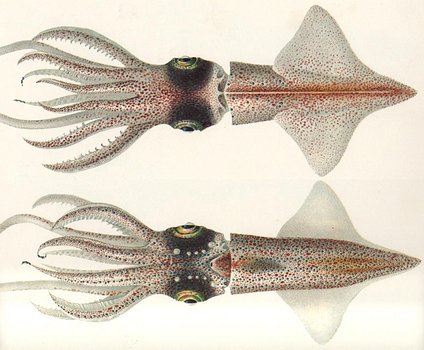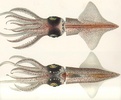Abraliopsis chuni
Kotaro TsuchiyaIntroduction
A. chuni was originally based on the illustrations of an enoploteuthid squid (38 mm ML, mature female) from the Indian Ocean, North Equatorial Current, in Chun (1910). While the specimen illustrated has been located and designated as the lectotype, no adequate description has been published.
Characteristics
- Tentacle clubs
- Two rows of distinct different-sized hooks on manus with largest ventral hooks over 3 times height of dorsal counterpart (judging from drawing).
- Carpal flap and aboral keel present.
- Two rows of distinct different-sized hooks on manus with largest ventral hooks over 3 times height of dorsal counterpart (judging from drawing).
- Arms
- Arms IV relatively long.
- Arms IV relatively long.
- Hectocotylus and male sexual dimorphism
- Male hectocotylization uncertain.
- Male hectocotylization uncertain.
- Integumental Photophores (determined from the title illustration above)
- Ventral mantle with six narrow longitudinal stripes of large integumental organs; no scattered intermediate small organs between stripes; a distinct wide mid-ventral photophore-less strip present.
- Ventral head with three narrow, longitudinal stripes and no intermediate scattered organs between them.
- Stripes of organs along ventral side of arm III and dorsal side of arm IV are not interrupted.
Comments
Abraliopsis chuni is probably a member of the subgenus Pfefferiteuthis. It shares having a carpal flap and large keel on the tentacular club with Abraliopsis species P, V and affinis. The latter differs with its restricted distribution (Eastern Tropical Pacific) and its distinctive mantle photophore pattern. Insufficient information is known to determine how similar it is to the other two species. See the A. (Pfefferiteuthis) page for a comparison of species in the subgenus. At present identification of A. chuni is based on its location in the Indian Ocean.
Nomenclature
Chun (1910) redescribed Abraliopsis morisii (Vérany, 1839) from Atlantic and Indian Ocean specimens. The illustrations accompanying the text clearly show that more than one species was included in the description. Subsequently, Nesis (1982) named, on the basis of these illustrations, two new species of Abraliopsis (i.e., A. atlantica and A. chuni). More recently, the squids that were illustrated were located and designated as lectotypes of their respective species (Glaubrecht. and Salcedo-Vargas, 2000).Distribution
Geographical Distribution
The only reliable record is that of the type specimen from the Indian Ocean, North Equatorial Current, 1°49'N, 45°29'E.
References
Okutani, T. 1974. Epipelagic decapod cephalopods collected by midwater tows during the EASTROPAC Expedition, 1967-1968 (systematic part). Bulletin of Tokai Regional Fisheries Research Laboratory, 80:29-118.
Glaubrecht, M. and M.A. Salcedo-Vargas. 2000. Annotated type catalogue of the Cephalopoda (Mollusca) in the Museum für Naturkunde, Humboldt University of Berlin. Mitteilungen aus dem Museum für Naturkunde Berlin, Zoologischen, 76(2):269-282.
Nesis, K. N. 1982. Abridged key to the cephalopod mollusks of the world's ocean. 385,ii pp. Light and Food Industry Publishing House, Moscow. (In Russian.). Translated into English by B. S. Levitov, ed. by L. A. Burgess (1987), Cephalopods of the world. T. F. H. Publications, Neptune City, NJ, 351pp.
Young, R.E. 1972. The systematics and areal distribution of pelagic cephalopods from the sea off southern California. Smithsonian Contribution to Zoology, 97:1-159.
Title Illustrations

| Scientific Name | Abraliopsis chuni |
|---|---|
| Location | North Equatorial Current, Indian Ocean at 1°49'N, 45°29'E (station 256). |
| Reference | Chun, C. 1910. Die Cephalopoden. Oegopsida. Wissenschaftliche eregebnisse der deutschen tiefsee expedition auf dem dampfer "Valdivia" 1898-1899, 18(1):1-401(Plate V) |
| Sex | Female |
| Life Cycle Stage | Mature |
| View | Dorsal (top), ventral (bottom) |
| Size | 38 mm ML |
About This Page
Kotaro Tsuchiya

Tokyo University of Fisheries, Tokyo, Japan
Page copyright © 2014 Kotaro Tsuchiya
All Rights Reserved.
- Content changed 21 January 2014
Citing this page:
Tsuchiya, Kotaro. 2014. Abraliopsis chuni . Version 21 January 2014 (under construction). http://tolweb.org/Abraliopsis_chuni/19684/2014.01.21 in The Tree of Life Web Project, http://tolweb.org/









 Go to quick links
Go to quick search
Go to navigation for this section of the ToL site
Go to detailed links for the ToL site
Go to quick links
Go to quick search
Go to navigation for this section of the ToL site
Go to detailed links for the ToL site